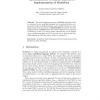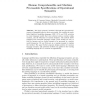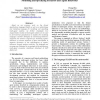KES
2008
Springer
14 years 3 months ago
2008
Springer
This paper presents a user interface to the User-Centred Knowledge Model (t-UCK). T-UCK is a knowledge modelling tool for designing knowledge-intensive systems. The model centres r...
DAGSTUHL
2004
14 years 4 months ago
2004
ns to define the abstract modelling language that determines the structure of the models that are to be used a two-step meta-modelling approach turned out as most adequate. In the ...
WICSA
2008
14 years 4 months ago
2008
Modern systems modelling languages frequently support the use of multiple views in order to provide flexible, extensible, and rich mechanisms for capturing system characteristics....
CAISE
2008
Springer
14 years 5 months ago
2008
Springer
Abstract. The model management operator ModelGen translates a schema expressed in one modelling language into an equivalent schema expressed in another modelling language, and in a...
UML
2000
Springer
14 years 7 months ago
2000
Springer
User interfaces (UIs) are essential components of most software systems, and significantly affect the effectiveness of installed applications. In addition, UIs often represent a s...
ECMDAFA
2007
Springer
14 years 7 months ago
2007
Springer
Abstract. This paper presents a method to describe the operational semantics of languages based on their meta-model. We combine the established high-level modelling languages MOF, ...
FM
1999
Springer
14 years 7 months ago
1999
Springer
Abstract. The emerging Unified Modelling Language has been touted as merging the best features of existing modelling languages, and has been adopted by leading companies and vendo...
GCC
2003
Springer
14 years 8 months ago
2003
Springer
Cooperative computing is becoming inevitable with the emerging of service-oriented computing and GRID becoming a ubiquitous computing resource. It is widely recognized that agent t...
IAT
2003
IEEE
14 years 8 months ago
2003
IEEE
Based on our previous work on the formal specification language SLABS as well as a methodology and modelling language for modelling and specifying multi-agent systems, we further ...
SELMAS
2004
Springer
14 years 8 months ago
2004
Springer
Abstract. This paper presents an agent-oriented modelling language and environment CAMLE. It is based on the conceptual model of multi-agent systems (MAS) proposed and formally def...



